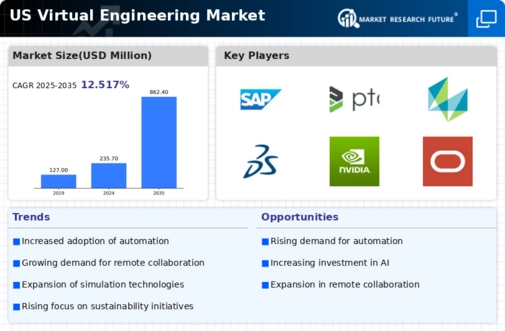The US Virtual Engineering Market has been experiencing significant growth as organizations increasingly adapt to innovative technologies for design, analysis, and optimization processes. The competitive landscape features a mix of established players and emerging companies that are leveraging advancements in software, cloud computing, and simulations to enhance their offerings. Firms are focusing on improving efficiency, reducing time-to-market, and lowering costs through virtual engineering solutions. The competitive insights reveal that key players are investing heavily in research and development to stay ahead of technological advancements and cater to evolving customer needs.
Companies are also collaborating and forming strategic partnerships to expand their capabilities and market reach, thereby intensifying the competition within the sector.ANSYS has solidified its position in the US Virtual Engineering Market through advanced simulation technologies that cater to a variety of industries. The company's focus on innovation and extensive portfolio of products enables it to address complex engineering challenges suitable for sectors such as aerospace, automotive, electronics, and manufacturing. With its robust simulation software platform, ANSYS empowers engineers to predict product performance and optimize designs without physical prototypes, thus driving efficiency and reducing costs for businesses across the nation.
The company’s strengths lie in its user-friendly interface, high fidelity of simulations, and the ability to integrate with other platforms, facilitating seamless workflows. ANSYS has also made significant strides in securing strategic partnerships and collaborations, further enhancing its competitive edge in the rapidly evolving market.Emerson Electric has emerged as a notable player in the US Virtual Engineering Market, offering a range of products and services aimed at optimizing operations and enhancing productivity for various industries. The company's key offerings include software solutions for automation, control, and predictive maintenance, giving organizations the tools needed to effectively manage their engineering processes.
Emerson Electric's strengths include its deep industry expertise and a comprehensive product suite that provides substantial benefits in efficiency and reliability. The company's market presence is further bolstered by its ongoing investments in research and development, which enable it to keep pace with technological advancements. Emerson Electric has also pursued strategic mergers and acquisitions that have expanded its capabilities, enhanced its service portfolio, and allowed for greater integration of its solutions into engineering practices across the US. Through these initiatives, Emerson Electric is positioned well in the competitive landscape of the US Virtual Engineering Market.






















